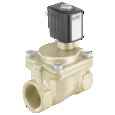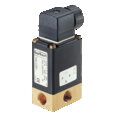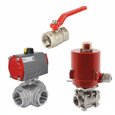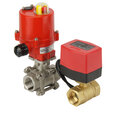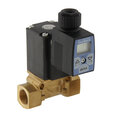Electric Ball Valve vs Solenoid Valve
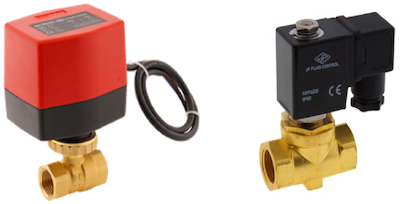
Figure 1: An electric ball valve (left) and a solenoid valve (right)
Electric ball valves and solenoid valves are both automated valves used to control media. Their operational differences make it clear when one valve type should be used over the other for certain applications. This article focuses on the specific criteria that distinguish solenoid and electric ball valves to help make the selection decision between the two valves clear and easier.
Check out our selection of solenoid valves and ball valves!
What is a solenoid valve?
A solenoid valve is an electromechanical device consisting of a coil surrounding a plunger that connects to a seal or valve mechanism. When current flows through the coil, it creates a magnetic field that moves the plunger, which opens or closes the valve. For more information, read our solenoid valve overview article.
What is an electric ball valve?
An electric ball valve has an electric motor that rotates a ball within the valve's body. There is a port through the middle of the ball. When the valve opens, the ball's port aligns with the inlet and outlet ports, allowing flow through the valve. When the valve closes, the port is perpendicular to the inlet and outlet ports, and the body of the ball blocks flow through the valve. Our ball valve overview article further explains how these valves work.
Electric ball valve vs solenoid valve
Before choosing a valve for an application, a user must fully understand how that valve will work in the system. This section assumes the user has that knowledge and focuses on the factors that can help decide between using a solenoid valve or an electric ball valve in an application:
- On/off control vs proportional control
- Speed
- Flow rate
- Dirty media
- Power consumption
- Failure position
- Operating pressure
- Cost
- Size
- Maintenance
- Materials
On/off control vs proportional control
Basic solenoid valves and electric ball valves are intended for on/off control. However, each type of valve has a design option for more precise flow control. To learn more, read about proportional solenoid valves and v-port ball valves.
Speed
Electric ball valves typically take at least 2 to 3 seconds, and sometimes much longer, to move from fully closed to fully open, or vice versa. Solenoid valves operate nearly instantaneously and therefore are the better option for applications that require an extremely fast response time from the valve. For example, compressed air, heating, and car wash applications.
Flow rate
Electric ball valves have higher flow rates than solenoid valves. There are several factors that determine flow rate, including valve type, pressure drop, and the Kv factor.
Dirty media
Electric ball valves can handle media with small particulates much better than solenoid valves. Particles can quickly clog a solenoid valve, whereas the ball valve's movement across its seat tends to clear out particles. Read a valve's manufacturer's guide for further guidance on the maximum particulate size and whether or not an application may require a filter in front of the valve. If considering a filter, first read our article on y-strainers.
Power consumption
Solenoid valves consume more power to operate than electric ball valves. Typically, solenoid valves require power to open or close and more power to hold the valve in its energized state. Electric ball valves, though, only use power to open or close and don't require power to stay in that position. However, there are solenoid valve designs that do not require power to stay in that position. See our article on latching solenoid valves to learn more.
Failure position
Solenoid valves are typically normally open or normally closed when de-energized. In the case of failure, such as a loss of electricity, these valves will be stuck in their de-energized position. A user can take this into account to determine whether the valve should be opened or closed in the case of failure. Electric ball valves do not typically have this option.
Operating pressure
Ball valves, especially high-pressure ball valves, can handle higher pressures than solenoid valves. The high-pressure ball valves can handle pressure up to approximately 700 bar (10.000 psi). On the other hand, a high-pressure indirect-acting solenoid valve can only handle pressure up to 90 bar (1300 psi). Typical indirect-acting solenoid valves handle pressure up to 16 bar (232 psi).
Cost
At the same port size, electric ball valves are more expensive than solenoid valves.
Size
Electric ball valves are typically the better option at 50 mm (2 inches) or larger. Furthermore, when selecting a solenoid valve smaller than 50 mm but larger than 12.7 mm (0.5 inches), choose a semi-direct or indirect solenoid valve instead of a direct-acting solenoid valve.
Direct, semi-direct, and indirect-acting solenoid valves
To operate, direct-acting solenoid valves only use the magnetic force created by the solenoid. Therefore, the required size of the solenoid becomes very expensive if the valve is larger than 12.7 mm.
Semi-direct and indirect-acting solenoid valves have the added benefit of using differential pressure between the valve's inlet and outlet to open or close the valve. Therefore, they can handle higher flow rates with relatively smaller solenoids.
Maintenance
Electric ball valves typically require less maintenance than solenoid valves across their entire lifetime. Read our articles on ball valve maintenance and solenoid valve maintenance for further information.
Materials
The most common materials for solenoid valve bodies are stainless steel, brass, and PVC. Ball valves have many more options, including carbon steel and bronze. Therefore, ball valves can function in a wider range of application parameters. Read our articles on solenoid valve housing material and chemical resistance of materials to learn more.
Applications
This section provides some examples of applications that solenoid valves are more suitable for and applications that electric ball valves are more suitable for.
Solenoid valve applications
- Irrigation: Irrigation systems need quick on/off water control in order to effectively control water distribution. Water irrigation solenoid valves provide this control more effectively than electric ball valves.
- Pneumatic control systems: Pneumatic control systems need fast valve response in order to effectively control moving components with compressed air. Solenoid valves provide this control.
Electric ball valve applications
- Chemical processing: Electric ball valves typically have a wider range of chemical resistance than solenoid valves.
- Oil and gas industry: For similar reasons, electric ball valves are more widely used in the oil and gas industry.
FAQ
What is the difference between a solenoid valve and an electric ball valve?
A solenoid valve operates faster than an electric ball valve. However, electric ball valves can handle higher flow rates and pressures than solenoid valves.




